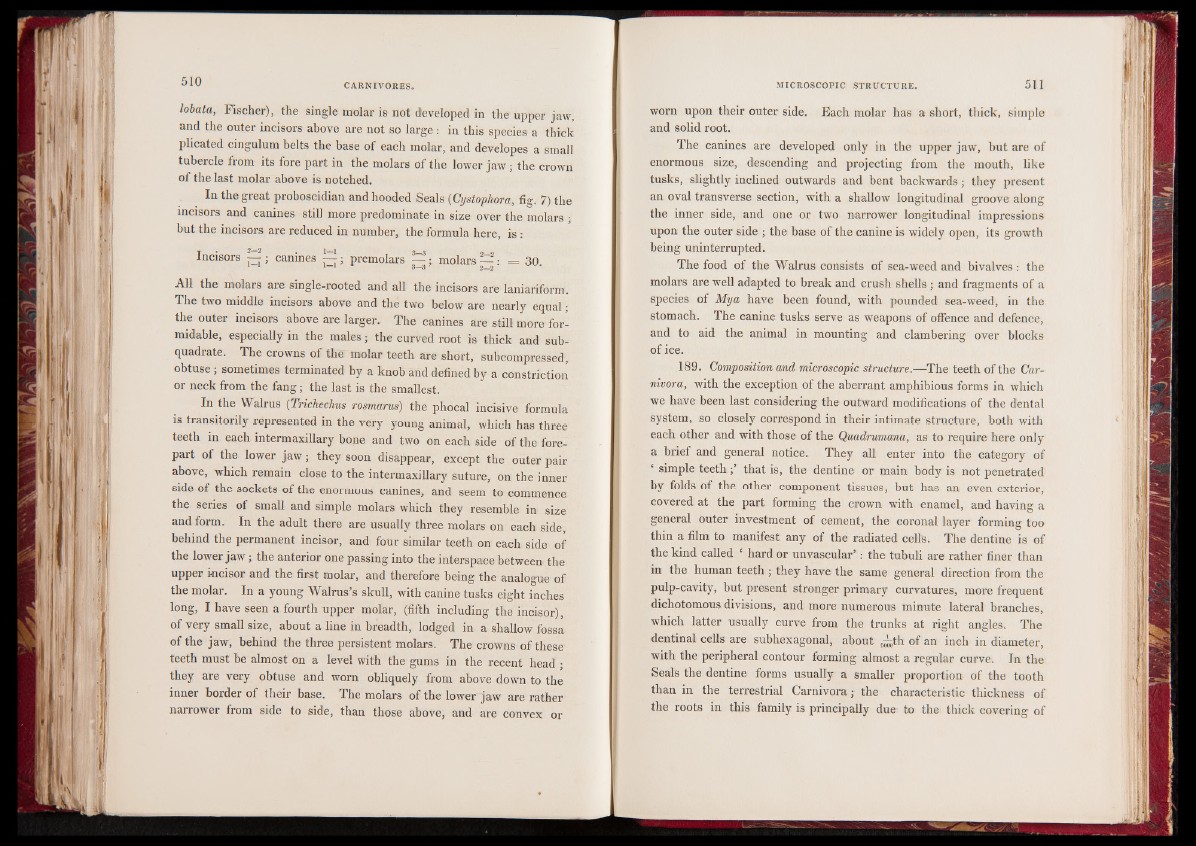
lobata, Fischer), the single molar is not developed in the upper jaw,
and the outer incisors above are not so large: in this species a thick
plicated cingulum belts the base of each molar, and developes a small
tubercle from its fore part in the molars of the lower jaw; the crown
of the last molar above is notched.
In the great proboscidian and hooded Seals (Cystophora, fig. 7) the
incisors and canines still more predominate in size over the molars ;
but tbe incisors are reduced in number, the formula here, is:
Incisors ^ ; canines premolars m o lars^: = 30.
All the molars are single-rooted and all the incisors are laniariform.
The two middle incisors above and the two below are nearly equal;
the outer incisors above are larger. The canines are still more formidable,
especially in the males $ the curved root is thick and subquadrate.
The crowns of the molar teeth are short, subcompressed,
obtuse; sometimes terminated by a knob and defined by a constriction
or neck from the fang; the last is the smallest.
In the Walrus (Trichechus rosmarus) the phocal incisive formula
is transitorily represented in the very young animal, which has three
teeth in each intermaxillary bone and two on each side of the forepart
of the lower jaw ; they soon disappear, except the outer pair
above, which remain close to the intermaxillary suture, on the inner
side of the sockets of the enormous canines, and seem to commence
the series of small and simple molars which they resemble in size
and form. In the adult there are usually three molars on each side,
behind the permanent incisor, and four similar teeth on each side of
the lower jaw | the anterior one passing into the interspace between the
upper i-ncisor and the first molar, and therefore being the analogue of
the molar. In a young Walrus’s skull, with canine tusks eight inches
long, I have seen a fourth upper molar, (fifth including the incisor),
of very small size, about a line in breadth, lodged in a shallow fossa
of the jaw, behind the three persistent molars. The crowns of these
teeth must be almost on a level with the gums in the recent head ;
they are very obtuse and worn obliquely from above down to the
inner border of their base. The molars of the lower jaw are rather
narrower from side to side, than those above, and are convex or
worn upon their outer side. Each molar has a short, thick, simple
and solid root.
The canines are developed only in the upper jaw, but are of
enormous size, descending and projecting from the mouth, like
tusks, slightly inclined outwards and bent backwards; they present
an oval transverse section, with a shallow longitudinal groove along
the inner side, and one or two narrower longitudinal impressions
upon the outer side ; the base of the canine is widely open, its growth
being uninterrupted.
The food of the Walrus consists of sea-weed and bivalves : the
molars are well adapted to break and crush shells ; and fragments of a
species of Mya have been found, with pounded sea-weed, in the
stomach. The canine tusks serve as weapons of offence and defence,
and to aid the animal in mounting and clambering over blocks
of ice.
189. Composition and microscopic structure.—-The, teeth of the Carnivora,
with the exception of the aberrant amphibious forms in which
we have been last considering the outward modifications of the dental
system, so closely correspond in their intimate structure, both with
each other and with those of the Quadrumana, as to require here only
a brief and general notice. They all enter into the category of
‘ simple t e e t h t h a t is, the dentine or main body is not penetrated
by folds of the other component tissues, but has an even exterior,
covered at the part forming the crown with enamel, and having a
general outer investment of cement, the coronal layer forming too
thin a film to manifest any of the radiated cells. The dentine is of
the kind called ‘ hard or unvaseular’ | the tubuli are rather finer than
in the human teeth ; they have the same general direction from the
pulp-cavity, hut present stronger primary curvatures, more frequent
dichotomous divisions, and more numerous minute lateral branches,
which latter usually curve from the trunks at right angles. The
dentinal cells are subhexagonal, about 5^th of an inch in diameter,
with the peripheral contour forming almost a regular curve. In the
Seals the dentine forms usually a smaller proportion of the tooth
than in the terrestrial Carnivoraj the characteristic thickness of
the roots in this family is principally due to the thick covering of